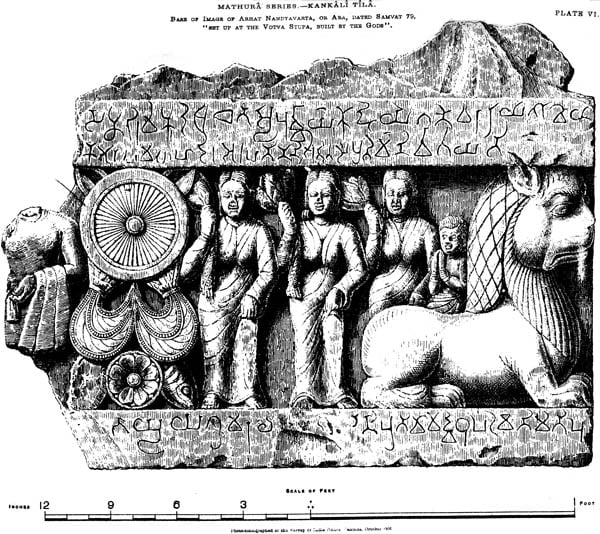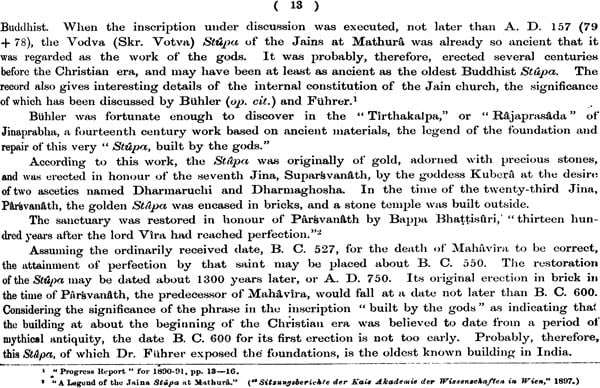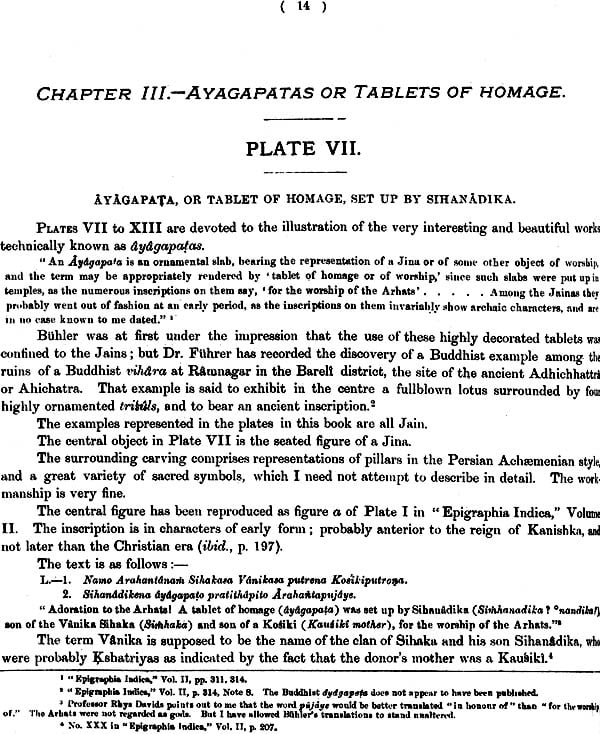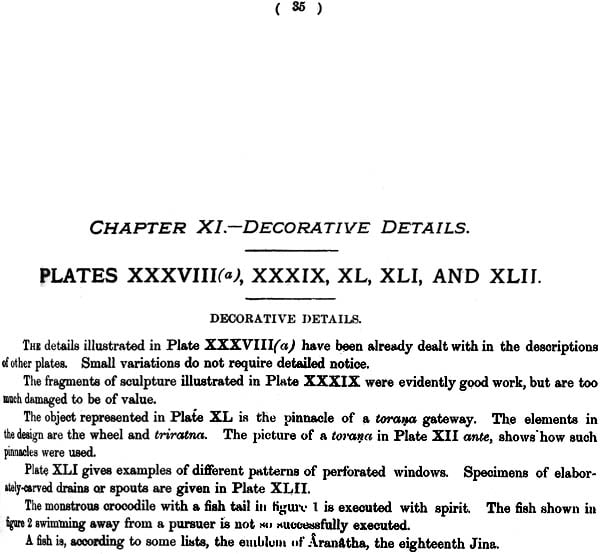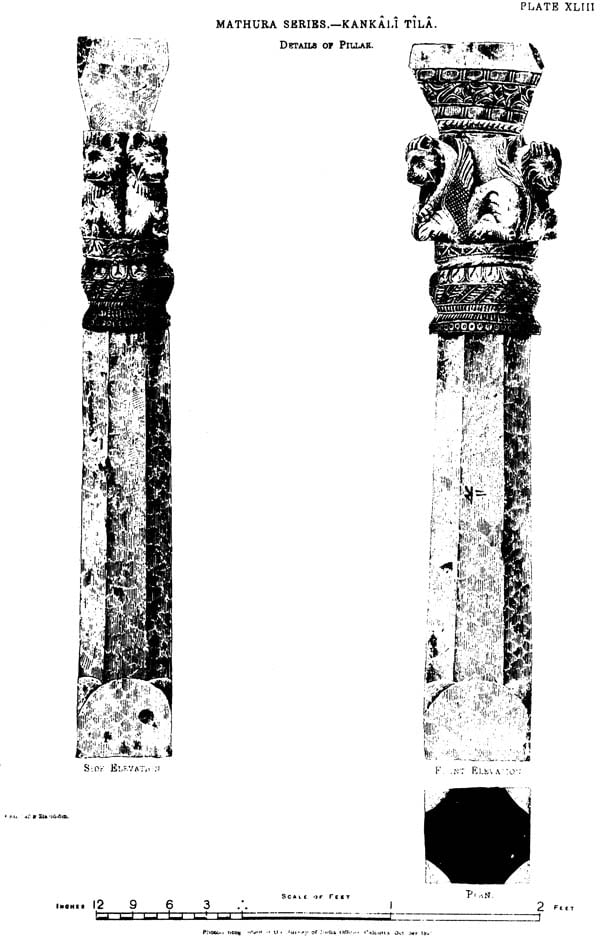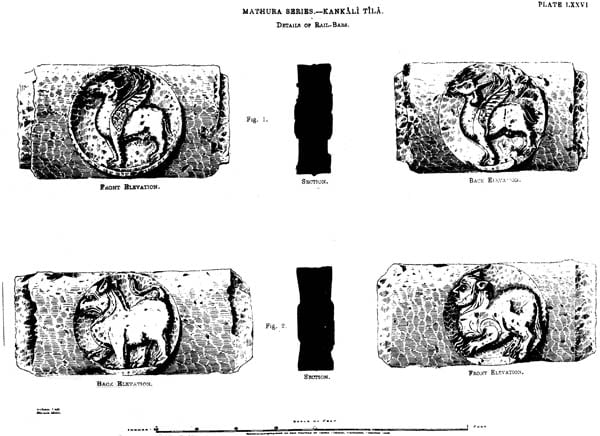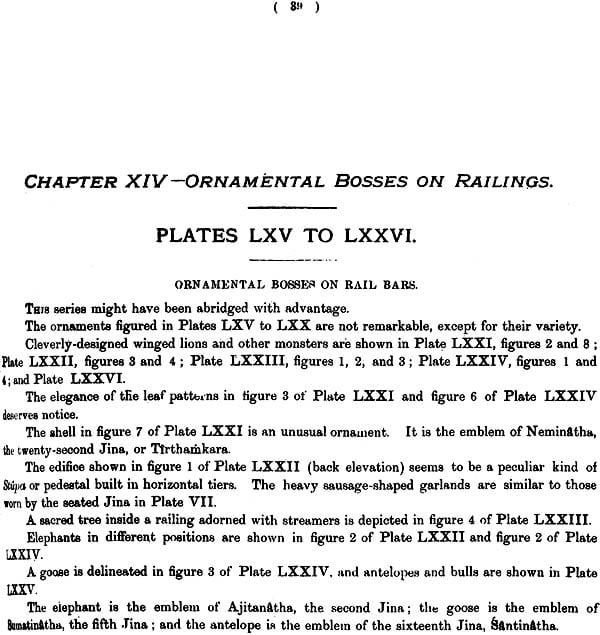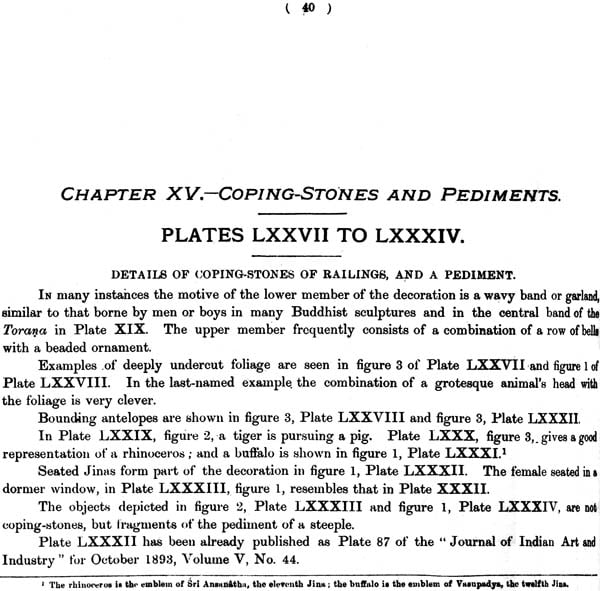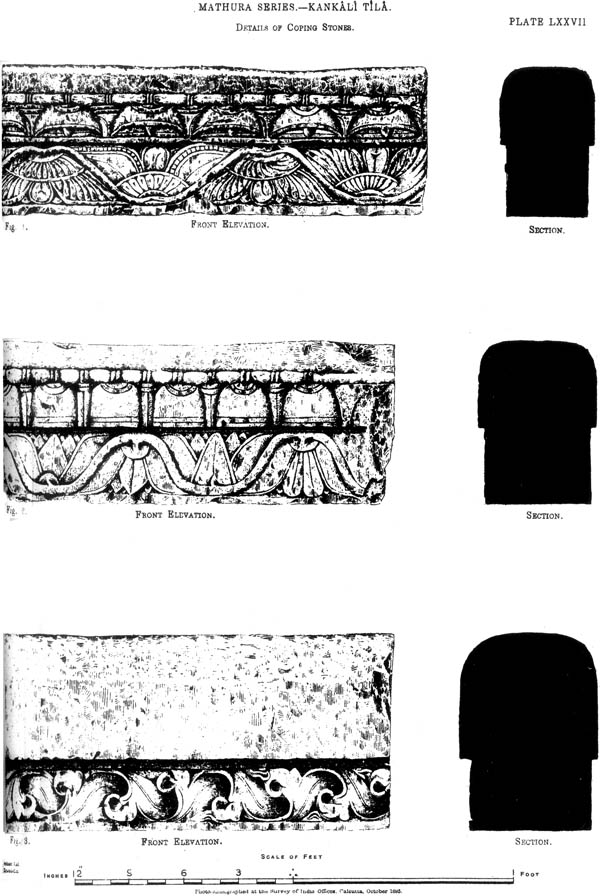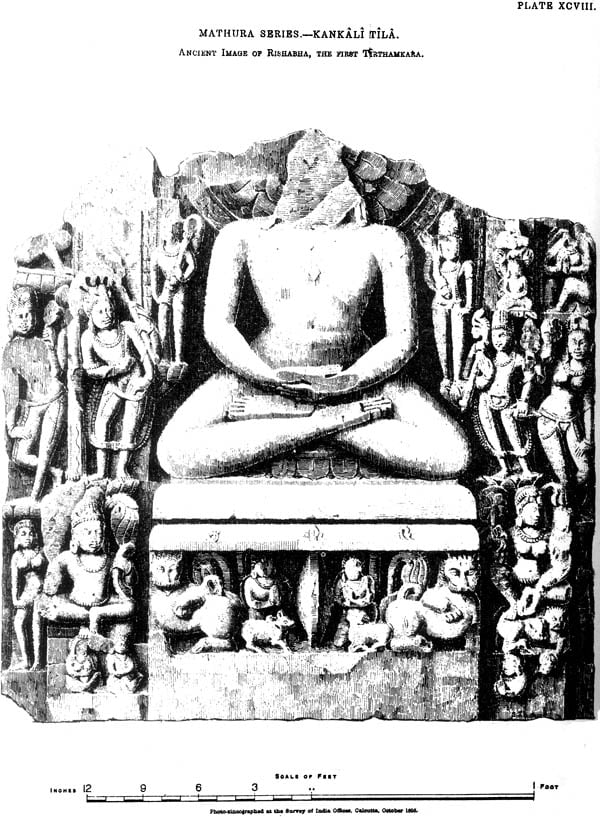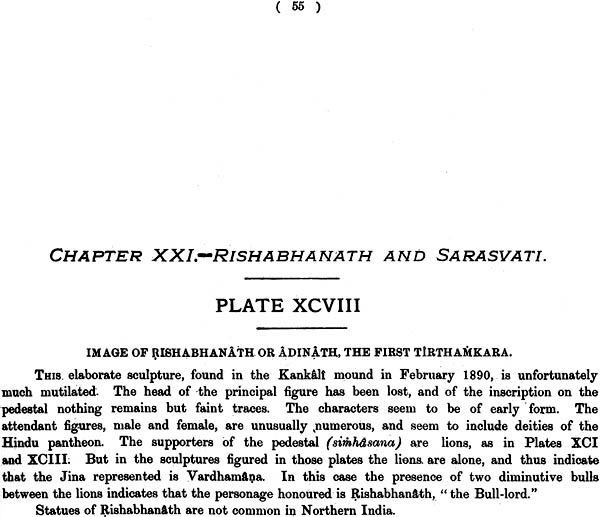
The Jain Stupa and Other Antiquities of Mathura
Book Specification
| Item Code: | NAL671 |
| Author: | Vincent A. Smith |
| Publisher: | ARCHAEOLOGICAL SURVEY OF INDIA |
| Language: | English |
| Edition: | 1994 |
| Pages: | 299 (89 B/W Plates) |
| Cover: | Hardcover |
| Other Details | 11.0 inch X 8.5 inch |
| Weight | 1.10 kg |
Book Description
The plates in this volume, excepting the frontispiece, Plate IIa, and the supplementary plates, were prepared several years ago under the supervision of Dr. Fuhrer, then Archaeological Surveyor and Curator of the Lucknow Provincial Museum. When he quitted the service of Government in the autumn of 1898 he left the plates without a word of explanatory text, although a monograph on the Jain remains at Mathura had been advertised as in an advanced stage of preparation by him. Sir Antony MacDonnell, G.C.S.I., Lieutenant-Governor of the North-Western Provinces and Chief Commissioner of Oudh, consulted me as to the best way of utilizing the fine series of plates prepared by Dr. Fuhrer. I advised that they should be published with a concise descriptive text, a short introduction, and references to any previous publications in which the subjects of them had been treated, no attempt being made to discuss the many questions of interest suggested by the plates. My recommendations were accepted, and, no one else being available to do the work, I undertook it. Any attempt to discuss at length the linguistic, palaeographical, historical, artistic, and other topics connected with the works of art illustrated would have involved prolonged research, and resulted in a very bulky treatise. The plates and inscriptions have, therefore, been left to speak for themselves with only so much annotation and explanation as seemed indispensable.
In some cases I have been unable to accept as correct the headings affixed to the plates by Dr. Fuhrer.
I am indebted in sundry matters of detail to notes prepared by Babu Puran Chandar Mukherji, who visited Mathura, and to some extent compared the plates with the originals in the Lucknow Museum. In a few cases he detected discrepancies between Dr. Fuhrer's headings to the plates and the labels affixed to the originals in the Museum. I have seen most of the originals from time to time, but official duties have prevented me from staying in Lucknow to make a minute examination of the objects described. Unfortunately no catalogue of the valuable Archaeological collections in the Lucknow Museum exists. The collection is housed in a dark crypt and very inadequately displayed.
It is impossible for me to compile a thoroughly satisfactory work from materials collected by another man and left in an incomplete state. But, notwithstanding its admitted and obvious limitations and deficiencies, I believe that this book will be of great interest to Orientalists. In the spelling of Indian words I have followed the system adopted in the "Epigraphia Indica." The transliterations of the inscriptions are given in Roman characters. Nothing would, I think, be gained by the use of Nagari type.
The Kankali, or Jaini, mound (Tila), from or near which most of the objects delineated in the plates of this work were excavated, stands in the angle between the Agra and Gobardhan roads, close to the south-west corner of the city of Mathura, and about half a mile south of the Katra. ( Frontispiece).
The name of the mound is derived from a modern temple, a mean shrine, which is occupied by an ancient carved pillar doing duty as a Hindu goddess, who has been dubbed KankaIi. This temple stands about midway between the well and the Jain Stupa which was excavated by Dr. Fuhrer in the season 1890-91. The mound is nearly rectangular in shape and is approximately 500 feet long by 350 feet broad. It long served as a quarry for bricks. Excavations for archaeological purposes have been made at various dates. General Cunningham worked at the western end in March and November 1871 ; Mr. Growse operated on the northern portion in 1875, and Dr. Burgess and Dr. Fuhrer extended the excavations to the eastern end at different times from 1887 to 1896. Mr. Harding, a predecessor of Mr. Growse as Magistrate of Mathura, also made some excavations. A grove of trees has recently been planted on what is left of the mound, which will probably not be further explored.
Mr. Growse and Mr. Harding discovered in or close to the KankaIi mound (1) two colossal statues of Buddha, each 7 1/2 feet high, supposed to be now in the Public Library at Allahabad; (2) several mutilated statues of finer stone and superior execution; (3) a large figure of an elephant, without its trunk, found in 1871 in a garden, with an inscription dated 39 in the reign of the Kushan King Huvishka; (4) a square pillar with four naked Jinas, dated in the year 9 in the reign of the Kushan King Kanishka; and (5) a considerable number of other statues and sculptures. Mr. Growse notes that the ancient figures are carved in coarse red sandstone with PaIi inscriptions. The mediaeval figures are executed in much finer material, and the inscriptions are in Sanskrit in characters of the eleventh century A. D.
The objects found by Cunningham were, with the exception of one ten-armed Brahmanical figure, all Jain. They included several colossal and life-size statues, both male and female, all more or less mutilated; many broken statues of the Jain hierarchs, several being inscribed; and at least six examples of the pillars of Stupa railings.
In Volume XVII of the "Reports" (page 111), Cunningham notes that in the season of 1881-82 he dug up many Jain figures, including one inscribed with the name of Vardhamana, the last of the 24 Jain pontiffs or Tirthamkaras. During the operations of the same season the Hellenistic group of Herakles strangling the Nemean lion (ibid, Plate XXX) was found "amongst the heaps of fragments lying about." No more exact description of the find-spot is given. Several railing-pillars with statues of dancing-girls in the collection at the Mathura Museum are figured in Plate XXXI of the same volume, without any indication of the find-spot of each. Unfortunately the collection in the Museum at Mathura has never been catalogued or properly arranged, and no record was kept of the spot where each object was found.
Cunningham's last visit to Mathura in the season of 1882-83 is the subject of some desultory notes in Volume XX of the "Reports." Plates III and IV in that volume illustrate a few curious sculptures in the local Museum. Plate IV, figure 1, represents a nude Jain saint preaching, with a Naga on each side adoring him. This sculpture probably belonged to the Digambara temple of the Kankali mound.
When Cunningham paid his early visits to Mathura in 1853, 1860, and 1863, as described in Volume I of the "Reports," pages 231-244, the Kankali mound had not been noticed.
Dr. Fuhrer's principal explorations of the Kankali mound were effected in the three seasons 1888-89, 1889-90, and 1890-91. The Provincial Museum Report for the year ending 31st March 1889 enumerates as received by the Museum the following Mathura antiquities, most of which seem to have come from the Kankali mound or its immediate neighbourhood :-
" 10 inscribed statues of several Svetambara Jinas of the Indo-Scythian period, four inscriptions of which are most important for the history of the Jainas ;
34 pieces of sculpture forming parts of a magnificent Svetambara Jaina temple of the time of the Indo-Scythian king Huvishka ;
a statue of Mahaviranatha surrounded by the remaining 23 Tirthamkaras ;
two colossal statues of the Jina Padmaprabhanatha, dated Samvat 1036 and 1134, respectively; four basements of Jina statues, inscribed Samvat 1134 ;
six bases of Buddha statues inscribed and dated in the regnal years of the Indo-Scythian rulers Huvishka, Kanishka, and Vasudeva;
an inscribed statue of the Bodhisattva Amogha Siddhartha of the first century A. D.;
10 inscribed Buddhist statues of the Indo-Scythian period ;
a colossal pillar with the life-size figure of a dancing-girl ;
19 Buddhist railing pillars of various sizes and patterns;
16 cross-bars of Buddhist railings;
12 pieces of copings of Buddhist railings;
a richly sculptured door-jamb, 10 feet high, of a Buddha temple of the Indo-Scythian period;
a beautifully carved stone umbrella, four feet in diameter, of a Buddhist Stupa ;
a four-faced lion capital of the time of the Andhras ;
24 exquisitely sculptured panels, some of which are inscribed in character, of the Indo-Scythian period;
a large slab, inscribed in the so-called shell characters, excavated from the Kankali Tila at Mathura."
The work was continued during the season 1889-90 when the Jain Stupa and the western Jain temple belonging to the Digambara sect were exposed: 80 images of Tirthamkaras, 120 pieces of stone railings, many miscellaneous sculptures, and numerous inscriptions, of which 17 belong to the Indo-Scythian (Kushan) period, from the year 5 to the year 86, were exhumed.
The most fruitful work was done in 1890-91. In the Museum Report for that year Dr. Fuhrer writes :-
"Liberal grants by the Local Government in the Public Works Department and the Museum Committee have enabled the Curator to finish the excavations of the Kankali Tila at Mathura during the cold season of 1890-91. The results of his work far surpass those of the previous two years, as the new finds form important additions to our knowledge of Indian history and art.
"He forwarded to the Museum 737 fine pieces of sculpture, comprising beautifully-finished panels, doorway, Toranas, columns, complete railings with copings and bars, statues of Tirthamkaras, &e.
"Amongst these sculptures is one which apparently possesses very considerable archaeological interest. It is a Torana bearing a relief which represents a Stupa worshipped by Centaurs and Harpies, or, as the Hindus would say, Kinnaras and Garudas or Suparnas.
“Centaurs have heen found on the Buddhist sculptures at Bharhut and Gaya, while Mathura has furnished the Silenus groups and Hercules strangling the Nemean lion. This new find is a further addition to the monuments which prove the influence of Hellenistic art among the Hindus of the last centuries preceding our era.
"Sixty-two of these sculptures are inscribed, hearing dates varying from 150 B. C. to A. D. 1023. On a beautifully carved Torana there is a brief dedication, written in an ancient Prakrit dialect and in characters which appear a little more archaic than these of Dhanabhuti's inscriptions on the gateway of the Bharhut Stupa, dated in the reign of the Sungas, or about B. C. 150.
A second inscription, incised in two lines on an oblong slab, gives us the name of the founder of one of the temples excavated last year. Its characters do not differ a much from those used in the earliest dated inscriptions of the Indo-Scythic period. As two temples have been discovered under the Kankali Tila, the natural inference from these inscriptions would be that one of them was built before 150 B. C. and the other considerably later, about the beginning of our era. Unfortunately, another circumstance has come to light which requires a modification of this assumption. The Curator has found several sculptures which have been carved out of more ancient ones.
"Thus, a pilaster bearing an inscription in characters of the Indo-Scythic period has been cut out of the back of an ancient naked Jina. Again, there is a small statue with a similar inscription cut out of the back of a sculptured panel bearing on the obverse a rather archaic inscription. These facts prove that the Jainas of the Indo-Scythic period at Mathura used for their sculptures materials from an older temple. Hence the discovery of the Torana, with its very archaic inscription, shows indeed that there was a Jaina temple in Mathura before B.C. 150.
Another important document is incised on the left portion of the base of a large standing statue, recording that this statue of Ara Tirthamkara was set up in Samvat 78 within the precincts of 'a Stupa built by the gods,' i.e. the Stupa was so ancient that at the time when the inscription was incised its origin had been forgotten. On the evidence of the characters, the date of the inscription may be referred with certainty to the Indo-Scythian era, and is equivalent to A. D. 156. The Stupa which was laid bare last year must therefore have been built several centuries before the beginning of the Christian era; for the name of its builders would assuredly have been known if it had been erected during the period when the Jainas of Mathura carefully kept record of their donations.
Another donative inscription, dated Samvat 1080, proves, like the two colossal images with the dates Samvats 1036 and 1134, found in 1889, that these ancient temples were used by the Jainas during the greater part of the eleventh century, and that their destruction happened in very late times."
The Museum Report for the year ending on the 31st March 1896 describes some further finds close to the Kankali mound. Dr. Fuhrer writes :-
"The Archaeological Surveyor, North- Western Provinces and Oudh, forwarded 57 ornamental slabs of great finish and artistic merit and 15 inscribed bases of images of Tirthamkaras, which formed part of an ancient Jaina Stupa, dating from the second century B. C. These sculptures were found in the course of excavations carried out in the unexplored fields adjoining the Kankali Tila at Muttra (Mathura), which mound in 1889-91 had furnished the valuable and comprehensive collection of Jaina antiquities exhibited in the Museum. Like the numerous inscriptions found in former years, the new documents contain a considerable number of names of Jaina monks, and give in many instances longer spiritual pedigrees. One inscription especially, dated Samvat 299, and inscribed on the base of a life-size statue of Arhat Mahavira possesses, in spite of the omission of the reigning king's name, a considerable interest, and, in all probability, indicates that the dates of the Kushana kings of Mathura must be interpreted otherwise than is usually done. Hitherto the dates of the Kushanas have been taken to be years of the Saka era of 78 A. D., supposed to have been established by king Kanishka ; but on the strength of this inscription it would seem that the beginning of this northern era must fall in the first half of the first century B. C.
Dr. Fuhrer from time to time sent to the late Dr. Buhler impressions and photographs of the inscriptions and sculptures discovered, a selection from which was published by Dr. Buhler in the "Epigraphia Indica." In Volume I of that publication in the articles entitled "New Jaina Inscriptions from Mathura " and "Further Jaina Inscriptions from Mathura" (pages 371-397) thirty-five inscriptions from the Kankali mound were admirably edited.
The article entitled "Further Jaina Inscriptions from Mathura," in Volume II (pages 195-211) gave forty-one additional documents, and the article entitled "Specimens of Jaina Sculptures from Mathura" (pages 311-323), illustrated by, four plates, supplied valuable explanations of some of the most interesting sculptures.
These writings of Buhler have been freely quoted in the descriptions of the plates in this volume.
Although the necessarily restricted plan of this work precludes me from attempting any elaborate discussion of the numerous topics of interest suggested by the plates, a few words pointing out some of the most obvious lessons to be, learned from the discoveries in the Kankali mound will help the reader to take an intelligent interest in the drawings.
The plates throw light, among other things, on the history of the Indian, or Brahmi, alphabet, on the grammar and idiom of the Prakrit dialects, on the development of Indian art, on the political and social history of Northern India, and on the history, organization, and worship of the followers of the Jain religion.
The exact date of the earlier sculptures must remain uncertain until the era used by the great Kushan kings, Kanishka, Huvishka, and Vasudeva has been determined. That era may, perhaps, prove to be the same which is used in the Kharoshthi inscriptions from the neighbourhood of Peshawar, and has been supposed to be either identical, or nearly coincident, with the era B. C. 57, known as the Malava or Vikramaditya era. The theory of Fergusson and Oldenberg that Kanishka founded the Saka era of A. D. 78 is not now generally accepted, although M. Specht still supports it. M. Sylvain Levi places the accession of Kanishka at about the Christian era. I am satisfied, having regard to the numismatic evidence that event cannot be placed earlier than A. D. 30. Everyone is agreed that the Kushan era, which undoubtedly dates from the accession of Kanishka, cannot have begun later than A. D. 78, nor earlier than B. C. 57.
The Mathura inscriptions dated in the undetermined era range certainly from the year 5 to the year 98. The years 5 and 98, therefore, lie respectively between the limits of B. C. 52 and A. D. 83, and A. D. 41 and A. D. ] 76. The latest inscription found is dated in V. S. 1134, or A. D. 1067. The documents may, consequently, be assumed to cover a period of nearly eleven centuries, from the beginning of the Christian era to the middle of the eleventh century A. D.
The undated inscriptions in Plates VII and X may be referred to as examples of early records dating probably from about a century before the beginning of the Christian era. Their linguistic and palaeographical peculiarities have been commented on by Buhler.
The document reproduced in Plate XIV is dated in the year 42, which may be assumed as approximately equivalent to B. C. 15. It is of special interest as mentioning the great Satrap (Mahakshatrapa) Sodasa, and determining his date as soon as the era used by him shall have been determined. That era is probably distinct from the era used by the Kushan kings.
The artistic merit of many of the sculptures is apparent, although in some cases the drawings fail to do full justice to the originals. The deep undercutting of much of the ornament is specially noticeable. The existence of Hellenistic works of art at Mathura has been long known, the most conspicuous examples being the so-called Silenus groups, and the Herakles strangling the Nemean lion. In the plates of this work Hellenistic influence may, I think, be traced. It was probably the result of intercourse with the Alexandrian school, which delighted in marine monsters and fantastic decoration. The general design of decoration in panels like that reproduced in Plate VIII seems to me to be decidedly Hellenistic. Attention is also invited to the description of Plate XIX.
The vine shown on the left border of Plate X is certainly Hellenistic. The sculpture is probably too early in date to be Graeco-Roman.
The harpies and centaurs of Plates XV and XVI obviously resemble to some extent those familiar in Greek art, although it is possible that they were borrowed directly from Assyria or Babylonia. The winged lions of the capitals in Plates XLIII to XLVI seem to be certainly of Assyrian or Babylonian origin. Other features of the capitals are Persian. The sculptures taken as a whole, though thoroughly Indian in subject, and for the most part in treatment, undoubtedly show a considerable amount of adaptation of foreign ideas.
Buhler has emphasized the lesson taught by the Mathura discoveries that Indian art was not sectarian. All religions, Buddhist, Jain, and Brahmanical, used the art of their age and country, and all alike drew on a common store-house of symbolic and conventional devices. Stupas, sacred trees, railings, wheels, and so forth, were available equally to the Jain, Buddhist, or orthodox Hindu as religious symbols or decorative elements.
The discoveries have to a very large extent supplied corroboration to the written Jain tradition, and they offer tangible incontrovertible proof of the antiquity of the Jain religion, and of its early existence very much in its present form. The series of twenty-four pontiffs (Tirthamkaras), each with his distinctive emblem, was evidently firmly believed in at the beginning of the Christian era.
The inscriptions are replete with information as to the organization of the Jain church in sections known as gana, kula, and sakha, and supply excellent illustrations of the Jain books. Both inscriptions and sculptures give interesting details proving the existence of Jain nuns, and the influential position in the Jain church occupied by women.
Dr. Fuhrer ("Progress Report" for 1890-91, page 13) states that in all 110 Jain inscriptions were collected at Mathura.
Most of those found in 1889 came from the central temple in the mound. The inscribed images dated V. S. 1038 and 1134 (Plates XCV and XCVI) are quoted by Dr. Fuhrer as proving that this central temple belonged to the Svetambara sect, but I notice that the images are nude.
The finds of 1890, he says, chiefly come from the second Jain temple, which according to a Nagari inscription, was still in the hands of the Digambara sect as late as V. S. 1080, A. D. 1023.
According to Dr. Fuhrer the mound also contained remains of a Buddhist vihara and of a Vaishnava temple. Some of the sculptures depicted in this work may belong to Buddhist or Brahmanical buildings, but most of them are certainly Jain. A few of the objects illustrated seem to have been included by mistake in this collection, as they came, according to the labels affixed to them, from places in Mathura distant from the Kankali mound. The supplementary plates are from photographs supplied by Mr. Mukherji.
| List of Plates | i-iii | |
| Introduction | 1-6 | |
| Description of plates | 7 | |
| Chapter I | Maps, views, and plans | ib |
| Chapter II | The Arhat Nandyavarta | 12 |
| Chapter III | Ayagapatas, or Tablets of Homage | 14 |
| Chapter IV | Veneration of a Stupa | 22 |
| Chapter V | Sculptured panels | 24 |
| Chapter VI | Naigamesha-Namesa | 25 |
| Chapter VII | A Torana | 27 |
| Chapter VIII | Decorative work | 28 |
| Chapter IX | Torana pillars | 29 |
| Chapter X | Sundry carvings | 30 |
| Chapter XI | Decorative details | 35 |
| Chapter XII | Pillars and capitals | 36 |
| Chapter XIII | Railing pillars | 37 |
| Chapter XIV | Ornamental bosses on rail bars | 39 |
| Chapter XV | Coping stones and pediments | 40 |
| Chapter XVI | A seated saint | 41 |
| Chapter XVII | Sundry sculptures | 42 |
| Chapter XVIII | Quadruple Jain images | 46 |
| Chapter XIX | Vardhamana | 49 |
| Chapter XX | Colossal Jain images | 53 |
| Chapter XXI | Rishabhauath and Sarasvati | 55 |
| Chapter XXII | Sundry sculptures | 58 |
| Chapter XXIII | Supplement | 61 |

